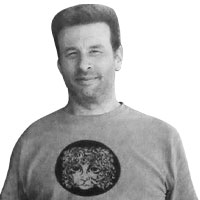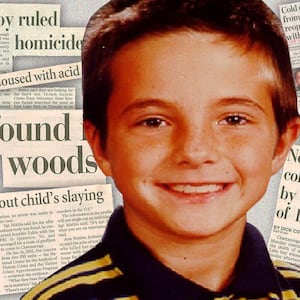On May 19, 2004, 21-year-old Sarah Fox, a student at Juilliard’s prestigious drama school, bid her roommate goodbye and went out for a run.
The roommate, Patrick Dall’Occhio, a budding actor and improv comic, had taken the day off to run some errands. After doing laundry and checking in on family by phone, Dall’Occhio sat down in front of the TV with a pizza and a pint of Ben & Jerry’s.
Fox never returned from her run that afternoon, but Dall’Occhio figured she must have stayed over at a friend’s house and had forgotten to check in, so he wasn’t overly worried. But the next day, he got a call from Fox’s boyfriend, Matt D’Amico, with whom he’d grown up in Whittier, California. D’Amico, who lived around the corner and also went to Juilliard, was worried that he hadn’t heard from Fox since the day before. As time passed, Fox’s friends and classmates became increasingly concerned. They gathered at the apartment Fox and Dall’Occhio shared on Isham Street in Upper Manhattan.
ADVERTISEMENT
“And everyone is trying to frantically figure out, like, what was happening,” Dall’Occhio recalled to The Daily Beast last week. “Everybody kind of knew something was wrong.”
Fox had left her wallet at home, and one of her friends took her MetroCard down to the subway station on the corner to see if it had been used that day. It hadn’t. They called the police, but someone over the age of 18 who does not have a cognitive, mental, or brain disorder, has the “right to go missing” and won’t get much immediate attention from law enforcement absent proof their disappearance was “involuntary.” Dall’Occhio created a flyer on his computer asking anyone with information about Fox’s whereabouts to call, and he and the others broke off into search teams, scouring the area. But they were “going in circles” without results, said Dall’Occhio. Then, someone in Fox’s circle managed to get the attention of a local reporter, who took the story “and ran with it,” according to Dall’Occhio. And that’s when the NYPD started paying attention.
Six days after Fox put on her jogging gear and left the apartment, a volunteer search party made up of Fox’s family and friends found her naked, decomposing corpse in a secluded section of nearby Inwood Hill Park, encircled by 24 yellow tulip tree blossoms and branches. The body, which investigators identified through dental records, was lying face up near a running path Fox often used, and seemed to have been posed with its legs spread apart. One of Fox’s ribs was broken, and her larynx was crushed. She was missing her right hand, which was the result of animals scavenging for food, cops said. There was no sign of a struggle, and police didn’t believe the 5-foot, 2-inch Fox had been sexually assaulted. The cause of death was strangulation, said the Medical Examiner’s Office, which ruled the case a homicide.

Fox’s decomposing corpse was found in a secluded section of Inwood Hill Park.
Justin Rohrlich“Sarah was an old soul,” said Dall’Occhio. “She was extremely kind, and just a thoughtful person, and extremely talented… I mean, just, someone who was filled with grace. Very few people have that. And it just felt like [she] was just kind of taken from everybody.”
Some detectives thought the positioning of the blossoms and branches appeared “ritualistic,” with the positioning of the legs striking them as a flourish by the killer meant to degrade the victim. Others believed Fox’s body may have just ended up in an unusual position when she died and that the flowers could have fallen during a recent rainstorm—which had also reportedly washed away a multitude of potentially useful evidence.
But no real answers ever emerged, and investigators were stumped. The case was one of the toughest he’d ever worked on, famed NYPD homicide detective Robert Mooney told the New York Post. No one could say if Fox’s death was a random killing, or if it was carried out by someone she knew. It wasn’t even clear how exactly Fox died, whether the killer strangled her with a rope, by hand, or used some other method altogether. The clothes Fox was wearing when she left her apartment—a white T-shirt, black running pants, and white sneakers—have never been recovered.
Detectives canvassed the area, asking passersby if they might have seen or heard anything strange around the time of the murder. They checked arrest records of homeless people who lived in the park, questioned Parks Department employees, and interviewed sex offenders who lived locally. Cops grilled neighbors and friends in the hunt for clues, and quickly ruled out D’Amico and Dall’Occhio as suspects.
“The police were doing whatever they could, they follow every lead,” said Dall’Occhio. “I gotta say, being interrogated was rough. But I had no problem giving full disclosure, because this isn’t about me feeling uncomfortable. It’s about helping to find Sarah.”
During the period that followed, Dall’Occhio said he avoided reading newspapers, didn’t watch the local news, and refused to listen to rumors. “I was just trying to keep it together. I had family come out because I needed an emotional support system… Those were the worst days of my life.”
It’s still a triggering subject for Fox’s friends and family. One former classmate, who studied ballet at Juilliard and now works as a realtor in the Carolinas, shrieked when she heard the mere mention of Fox’s name and hung up the phone. D’Amico declined to be interviewed for this story. Fox’s mother and sister did not respond to requests for comment.
In the days and months after Fox’s death, police cast a wide net, interviewing hundreds of people across Upper Manhattan who could have possibly killed her, including convicted sex offenders and psychiatric patients with violent histories. All of them were ruled out for various reasons. But police had been hearing from Inwood residents about a neighborhood “creep” and park regular named Dimitry Sheinman, and in June began looking into him as a potential suspect.
Sheinman, 39, was born in Moscow and moved to the U.S. with his mother shortly after his parents’ divorce in 1977. A trained artist and recovering drug addict, Sheinman scratched out a living as a house painter who sometimes accepted payment in cocaine, according to his father, who now lives in Brooklyn. Sheinman and his South African-born wife, Jane, met in New York in 1992 through mutual friends. They were married at City Hall in 2001, and their first daughter, Anna Rose, was born the following year.
Sheinman and his family lived at the northern end of Seaman Avenue, on the edge of Inwood Hill Park and across the street from Columbia University’s Baker Field. They had moved there from the Lower East Side with their dog, a large Rhodesian Ridgeback named Barundi, not long before Anna Rose was born.
Sheinman quickly developed a reputation for being odd and combative, especially when anyone scolded him for letting Barundi walk around unleashed. One resident, who asked that her name not be used because she still fears Sheinman, had an unusual encounter with him on a Saturday prior to Fox’s murder at the weekly farmers’ market on Isham Street, steps from Fox’s front door. A pet owner herself, the woman told The Daily Beast she innocuously asked Sheinman what breed of dog Barundi was.
“MY DOG IS JEWISH!” Sheinman snapped at her angrily before the woman’s friend pulled her away.
A couple of weeks after investigators homed in on Sheinman, they searched his apartment and seized a laptop, photos, clothing, and personal documents. Among them was a diary of Sheinman’s in which detectives reportedly discovered a passage about a girl in a park surrounded by flowers, which described a scene similar to how Fox’s remains were found.
At the end of August, Sheinman, who was then 39, agreed to sit down with NYPD detectives for questioning. During a 12-hour interview at the 34th Precinct, Sheinman claimed he was clairvoyant, and volunteered to describe the “visions” he had had about Fox’s killing.
“I will tell you that there were a couple of things found at the crime scene that only the killer would know,” retired NYPD Det. Sgt. Joseph Giacalone, who worked on the Fox investigation, told The Daily Beast. “If somebody says certain things about the crime scene in the interview, you know you got your man, bottom line, because nobody else knows about [those] specific things.”
As it turned out, Sheinman described things that cops had not yet made public: A stick that had been wedged between Fox’s legs to prop them open, the fact that one of Fox’s ribs had been broken, and the exact position of Fox’s hands and feet where her body lay. Sheinman claimed to have gone into a trance during the interview, informing detectives that Fox’s killer “just saw her and jumped her for no reason,” but that whoever did it “did not mean to kill her,” adding, “Whoever did this will do it again.”
In a 741-page book Sheinman self-published in 2015, which he billed as a “memoir in a novel form,” the murder victim is not named Sarah Fox, but Tara Wolfe. Sheinman, who had by then changed his name to Victor, painted himself as a psychic hero who just wanted to help find the real killer.
“Victor could not contain himself on his seat and was up, gesticulating,” Sheinman wrote. “He could vividly see the familiar path, but something other than just good understanding of the area’s topography was pulling him into the park. His knowledge of the locality assisted him in visualizing a figure hiding in the undergrowth, crouching, ready to leap on a jogger. Everywhere along the path the pavement was cracked. On the sides uneven chunks of asphalt were breaking off, mixing with rocks and twigs. The bridge loomed somewhere above. ‘He probably sprang up from the bushes and grabbed her in a chokehold.’ Victor proceeded to reenact the vision, showing the hold over the imagined victim. Then tightening his arm he gave it a twist. ‘And if he is careful, he’d want to move right out of sight. So, he probably rolled with her into the shrubs next to the road.’”
In Sheinman’s retelling, he then told detectives, “I keep on thinking he is really scared of getting caught, so perhaps he also hit her in the ribs to quickly silence her.”
“Did he break her ribs?” one of them asked.
“As a matter of fact, I think he could have!” Sheinman replied, according to the book. “He probably did!”
Sheinman, who did not respond to multiple requests for comment, was fully cooperative, his father said.
“My son voluntarily gave his DNA for [a] test,” Yuri Sheinman told The Daily Beast. “Not [a] match. Not [a] match.”
The New York Post outed Sheinman that December as the prime suspect in Fox’s murder. One of Jane Sheinman’s friends told the paper that she helped her try to hide the story by buying up all the copies in the neighborhood the day it hit newsstands—ultimately, to no avail.
It wasn’t his first run-in with the law, but it was by far the most serious allegation ever levied against him. In 1999, Sheinman was charged with assault after a dispute with a couple over loud music became physical, according to The New York Times, which reported that Sheinman also threatened two dog owners in 2002 and 2004.
One local dog owner, Charles DeFino, told The Daily Beast about Sheinman’s reaction when he asked him to put his own dog on a leash. Sheinman apparently took offense at the request, and began charging towards DeFino in a threatening manner, prompting DeFino to pick up a broken tree branch in case he needed to defend himself. Luckily, Sheinman walked away.
“He’s a big fucking guy,” said DeFino. “Huge.”
Regardless, once he was identified as the person police believed was responsible for Fox's death, Sheinman’s day-to-day life in Inwood became unbearable, according to his dad, who said most of the neighborhood took it as a given that Sheinman was guilty as charged.
The investigation continued, but cops didn’t have enough evidence to charge Sheinman with Fox’s murder. Five months later, in April 2005, Sheinman was arrested on misdemeanor assault charges after tangling with a dog and its owner in the same park where Fox was killed.
Yuri Sheinman, who is now 84, said he had advised his son to keep a low profile while detectives did their work.
“Don’t go in the park, don’t go in the street, people [are] very upset with you,” he recalled. “Because all newspaper or TV was full with this [news], without any proof.”
But Sheinman and his wife, who was by now eight months pregnant with their second child, decided one day to go to Inwood Hill Park with their 2-year-old daughter to relax. And that’s when a small, unleashed dog allegedly angered Sheinman by being too boisterous.
“Victor punches a simpleton whose dog jumps on Jane’s stomach, while the man is hissing ‘murderer’ at him with a trashy newspaper sticking out of his pocket,” Sheinman wrote on The Sheinman Source, a website he set up years later to explain his side of the story and advertise his “clairvoyant” services. “Within an hour, Victor is arrested for a misdemeanour by three detectives and walked away handcuffed in flip-flops, this time involuntarily, to the same precinct.”
“Human beings—sometimes you [are] not in control,” said Yuri Sheinman. “I don’t justify my son, he was stupid idiot in this case.”
As the case wound its way through the court system, Sheinman—who had been ordered to turn in his passport to authorities once he became a murder suspect—became concerned for his family’s safety in Inwood, he claimed on his website. They rented a cottage in Upstate New York to get away. In June 2005, the Sheinmans’ second daughter, Kate Alexandra, was born.
With the assault case still pending, Sheinman sold his apartment for $1 million and moved his expanding family to South Africa, where Jane had grown up. Sheinman managed to slip out of the country after apparently applying for a new passport using a slightly different spelling of his name. Living under a microscope was too much for the “thin-skinned” Sheinman to bear, said his father, who added that the compounding legal exposure nearly “destroyed” their relationship.
“I almost lost connection with him,” said Yuri Sheinman. “Another daughter was born, he left with two granddaughters. I don’t know them, they don’t know me. What about this story?”
Cops figured Sheinman was gone for good, and didn’t expect him to show up in court ever again. However, he continued to appear at all of his scheduled hearings and in February 2006, a jury found Sheinman guilty of attacking the dog walker. He was released on $100,000 bond posted by his dad, and in March 2006 was sentenced to three months in jail. The short stay behind bars severely impacted Sheinman’s already precarious mental state, his father said: “He was not stable. But in this case, prison… I believe it changed him 180 degrees, absolutely.”
When Sheinman was sprung that summer, he and Jane bought a house in a residential area of Cape Town called the City Bowl.
“The City Bowl, which is the heart of Cape Town is one of the most energetically charged locations in the world for reasons not outlined on tourist’s brochures, having to do with Earth’s chakra system,” Sheinman wrote on his website, now suggesting that he was God’s messenger on Earth. “Soon extrasensory perception became an integral part of his everyday life transmuting into what he later refers to as Hyper Clairvoyance,” it said, explaining that Sheinman considered himself to be a “portal” through which “The Messiah” sent powerful energy.
Sheinman then quit his job at a Cape Town art gallery to devote all his time to writing a spiritual manifesto he called “THE POWER.”
“It is the only True Religion that there has even [sic] been on any world besides Satanism, for there is only The Truth or the untruth, the rest are shades of gray from which most energy in the form of fear and pain is extracted,” Sheinman wrote.
Eight years after Sarah Fox’s murder, police still hadn’t made an arrest. Sheinman, for his part, was living (mostly) anonymously in Cape Town, far from his troubles in New York City. He sold his services as a supposed clairvoyant, claiming he could use his mind to troubleshoot anything from technological failures to insect bites.
Sheinman’s dad said his son “believes strongly he is [a] very, very genius healer, even if I don’t know,” explaining that Sheinman has made a little money from providing psychic readings “but not too much.”
“Some pay him, some not pay him—he doesn’t care [if] people pay him or not, he believes he [is] doing this for [a] very high purpose.”
In June 2012, Sheinman decided his manuscript, which he referred to as “The Book,” was ready to be released. He traveled to New York City to promote The Book, he explained on his website, but also went there “because moral responsibility demanded that [he] share who the probable murderer is with police.” Sheinman claimed to have enlisted four other psychics in South Africa who “independently of each other identified the name and identical details pointing to a single, probable murderer.”
When he arrived in Manhattan, Sheinman delivered a letter to police that he said contained secret new information he dug up with his group of fellow clairvoyants. The note reportedly identified a Juilliard teacher who cops said they ruled out as a suspect eight years prior. Investigators said Sheinman hadn’t brought them anything useful, something he vigorously disputes on his website, insisting on the veracity of his supernatural sources.
Sheinman returned to Cape Town later that summer. He has not been back to the U.S. since, his father said.
The biggest question is one that endures to this day: Did Dimitry Sheinman kill Sarah Fox? And if he didn’t do it, who did?
Many point out that being strange or belligerent doesn’t mean you’re a murderer, and that no physical evidence is known to exist linking Sheinman to the crime. At the same time, said Giacalone, “He’s still on the chart, let’s put it that way.”
In May 2013, the NYPD announced a potential breakthrough in the case.
“We’re not excluding Sheinman, but we are looking at two other guys right now,” NYPD Det. Mark Tebbens told the New York Daily News. “I’ve interviewed them already. They’ve denied it, but we’re doing forensic testing."
Tebbens, who died in 2015, said neither man had a criminal record, and that neither had been previously questioned by police. They had both been fingered by tipsters, one of whom called the NYPD Crime Stoppers hotline.
“This sets us back in a way that’s emotional,” Fox’s mom, Lorraine, told the Daily News, who said she wasn’t ever certain Sheinman had anything to do with her daughter’s death. “Time has gone on. Life has gone on. But what happened to Sarah has left us very damaged.” The Daily Beast was unable to reach Lorraine Fox.
Prising out the identities of the two additional suspects, or any details whatsoever about how they came to be persons of interest, proves nearly impossible. Giacalone was not comfortable broaching the subject, explaining that the information is known only to a select few and any leaks—if someone were so inclined, which Giacalone was not—would be easily traceable.
NYPD Lt. David Nilsen, who was once a lead investigator on the Sarah Fox case, now works for the Staten Island District Attorney’s Office. Ryan Lavis, a spokesman for the Staten Island DA, declined to make Nilsen available for an interview, referring The Daily Beast to the NYPD.
“The investigation remains active and ongoing,” NYPD spokesman Edward Riley told The Daily Beast, declining to provide further details.
Neighborhood gossip about who the other suspects could be continues to circulate, although many people’s theories today seem directed at other residents they simply don’t like.
Whoever the two were, nothing ever seemed to come of it. And although Sheinman’s dad insists his son is “completely clean,” Sheinman continued bringing attention to himself in connection with the case.

Sarah Fox was last seen leaving her apartment in Upper Manhattan for a jog.
Justin RohrlichDays before the 10th anniversary of Fox’s death, Sheinman invited a New York Post reporter into his home in Cape Town. He told the journalist that Fox loved him, and that her spirit spoke to him from the great beyond. Sheinman kept a photo of Fox under a glass tabletop in a room cluttered with a massage table, candles, and animal figurines, and said the picture was the portal through which they communicated.
“She is angry,” Sheinman said, claiming Fox knew the identity of the “real killer” and “wants this guy’s blood.”
“Sometimes I walk by and she winks at me, you know,” Sheinman continued. “And she knows: ‘I know exactly what you’re doing, and I love you.’”
Dall’Occhio, Fox’s roommate, still isn’t sure what to think. On one hand, he knows Sheinman had information only someone who was there would have been privy to. On the other, perhaps Sheinman came across the crime scene, or even watched the murder happen.
“Anything is possible, but I have no idea whether or not he’s the guy,” said Dall’Occhio. “What makes it worse is when somebody takes a crime like this, and essentially makes it about themselves.”
The last time Dall’Occhio heard from police about the case was about a decade ago, when investigators thought they had a DNA match from the CD player Fox had with her when she died. But the lead fizzled out when the “match” turned out to be cross-contamination from another piece of evidence in an unrelated case.
“For me, it’s been 17 years,” said Dall’Occhio. “I don’t think closure is one thing, I think you have stages, and I think there are things you kind of have to live with. And so, her body being recovered, I think, is a form of closure. Knowing what happened is a form of closure. That’s still open. You know, it’s not resolved. And it’s just infuriating.”
The case may still be solved, said Giacalone. People talk as they get older and face their own mortality, he explained. And suspects get sloppy. If all else fails, cash rewards always help, he said.
“There are people still working on this case,” said Giacalone. “That’s what the public has to know, [that] there are real people behind the scenes that take these cases very seriously. And they try to do their best every day to bring justice for the victim. That’s the bottom line.”
Today, Sheinman is going on 57 and is largely “preoccupied online,” according to his dad, who said his son recently chastised him for getting vaccinated against COVID-19.
“If you have not noticed yet, this world is the residence for many Gods and Goddesses, the most powerful of them being—Satan,” Sheinman wrote on Facebook last week. “In this 3rd stage of the New World Order, all religions based on belief systems will be joined into One World Religion so that most people will be able to worship The God openly. Next time someone calls you ‘boss,’ even if you are not a Satanist, you are in your full right to tell them that you are not Satan.”








